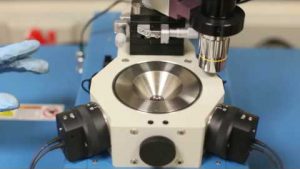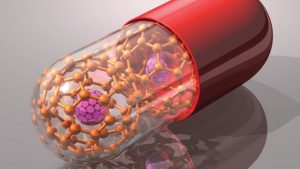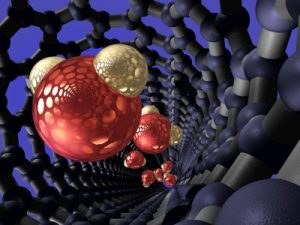Editorial note
Welcome to the latest edition of NanoNews brought to you by NPEP and partners once again. October was Breast Cancer Awareness month. In this month, we bring you some of the latest developments in nano and health in South Africa and around the world, helping to keep you informed about the myriad ways in which nanoscience and nanotechnology are changing our world.
A leader in nanotechnology and drug delivery
 Dr Lungile Thwala was born in Swaziland and obtained a Bachelor of Science degree (with majors in Chemistry and Biological Sciences) from the University of Swaziland (UNISWA) in 2007 and a Master of Science in Chemistry from the University of Johannesburg (UJ) in 2012. Thereafter, she enrolled as a PhD candidate at the University of Santiago de Compostela (USC) in Spain and the Universit`e Catholique de Louvain (UCL) in Belgium, after being awarded the NanoFar Grant under the NanoFar, Erasmus Mundus Joint Doctorate programme in nanomedicine and pharmaceutical innovation.
Dr Lungile Thwala was born in Swaziland and obtained a Bachelor of Science degree (with majors in Chemistry and Biological Sciences) from the University of Swaziland (UNISWA) in 2007 and a Master of Science in Chemistry from the University of Johannesburg (UJ) in 2012. Thereafter, she enrolled as a PhD candidate at the University of Santiago de Compostela (USC) in Spain and the Universit`e Catholique de Louvain (UCL) in Belgium, after being awarded the NanoFar Grant under the NanoFar, Erasmus Mundus Joint Doctorate programme in nanomedicine and pharmaceutical innovation.
Nano News hosts a popular writing workshop for scientists
 SAASTA, Roswika Media and UNISA joined forces on 7 July 2016 to host the first Nano News Writing Workshop this year at UNISA, Florida Campus in Johannesburg. Aimed at guiding scientists to better communicate science and nanotechnology in particular, the fully subscribed workshop brought together postgraduate students and senior researchers from different nano related sectors.
SAASTA, Roswika Media and UNISA joined forces on 7 July 2016 to host the first Nano News Writing Workshop this year at UNISA, Florida Campus in Johannesburg. Aimed at guiding scientists to better communicate science and nanotechnology in particular, the fully subscribed workshop brought together postgraduate students and senior researchers from different nano related sectors.
Prof. Mhlanga appointed as the head of the H2020 Programme
 The Department of Science and Technology (DST) has appointed Prof. Sabelo Mhlanga as the South African ‘Nanotechnology’ national contact point (NCP) for the European Union’s Horizon 2020 (H2020) Programme.
The Department of Science and Technology (DST) has appointed Prof. Sabelo Mhlanga as the South African ‘Nanotechnology’ national contact point (NCP) for the European Union’s Horizon 2020 (H2020) Programme.
Prof. Mhlanga’s appointment will benefit the entire SA National System of Innovation. He will be responsible for analysing H2020 calls in SA, disseminating information amongst the SA research community and facilitating thematic information systems amongst targeted SA research communities, among other roles. As theNCP on nanotechnology, he will also be responsible for coordinating Horizon 2020 projects in SA with a focus on nanotechnology. The appointment started in August 2016 till the end of the programme in 2020. “It is an important appointment and I am excited about it. It comes with a great deal of responsibility but it is great exposure for not just me, but UNISA as well,” he said.
Drug delivery of insulin through nanotechnology
 Successful administration of therapeutic proteins such as insulin via the oral route has long eluded the drug delivery community. A variety of factors, both physical and physiological, have hindered the myriad approaches to increasing the bioavailability of orally administered therapeutic proteins, including: 1) pre-systemic (along the gastro intestinal tract) degradation by enzymes; and 2) poor penetration of the intestinal mucosa (mucus layer) and epithelium (intestinal wall).
Successful administration of therapeutic proteins such as insulin via the oral route has long eluded the drug delivery community. A variety of factors, both physical and physiological, have hindered the myriad approaches to increasing the bioavailability of orally administered therapeutic proteins, including: 1) pre-systemic (along the gastro intestinal tract) degradation by enzymes; and 2) poor penetration of the intestinal mucosa (mucus layer) and epithelium (intestinal wall).
Even when bypassing the harsh, acidic environment of the stomach, the intestines pose significant obstacles to systemic uptake. For example, the lining of the gastrointestinal tract has a thick wall of epithelial cells covered by a layer of polysaccharides and mucus.
Nanomedicine in SA: the future and the concerns
 In an effort to catch up with global trends, South Africa launched its first nanotechnology innovation centre in 2007, with the Department of Science and Technology (DST) stressing that the country was ready to create an environment conducive to harnessing the potential benefits of nanotechnology. This was supported by the setting up of two world class nanotechnology research centres at CSIR and MINTEK. In 2011, South Africa became the first nation on the African continent to own a new US$15 million electron microscopy centre. The Centre for High Resolution Transmission Electron Microscopy (HRTEM) was constructed to enable the country and Africa to compete with the world’s best in nanoscience and nanotechnology research.
In an effort to catch up with global trends, South Africa launched its first nanotechnology innovation centre in 2007, with the Department of Science and Technology (DST) stressing that the country was ready to create an environment conducive to harnessing the potential benefits of nanotechnology. This was supported by the setting up of two world class nanotechnology research centres at CSIR and MINTEK. In 2011, South Africa became the first nation on the African continent to own a new US$15 million electron microscopy centre. The Centre for High Resolution Transmission Electron Microscopy (HRTEM) was constructed to enable the country and Africa to compete with the world’s best in nanoscience and nanotechnology research.
The nano drug delivery system in South Africa
 Nanotechnology covers the investigation, design, manipulation, measurement, modeling or fabrication of matter, structures, devices and systems that exist at nanoscale (or at very tiny atomic or molecular sizes). Nanotechnology is an emerging technology with enormous potential in information and communication technology, biology and biotechnology, medicine and medical technology. Novel nano- and biomaterials, and nano devices are fabricated and controlled by nanotechnology tools and techniques, and tune the properties, responses and functions of living and non-living matter at sizes below 100 nm. This field of science has a huge potential to be a game changer in the way we solve some of the world’s most critical development challenges.
Nanotechnology covers the investigation, design, manipulation, measurement, modeling or fabrication of matter, structures, devices and systems that exist at nanoscale (or at very tiny atomic or molecular sizes). Nanotechnology is an emerging technology with enormous potential in information and communication technology, biology and biotechnology, medicine and medical technology. Novel nano- and biomaterials, and nano devices are fabricated and controlled by nanotechnology tools and techniques, and tune the properties, responses and functions of living and non-living matter at sizes below 100 nm. This field of science has a huge potential to be a game changer in the way we solve some of the world’s most critical development challenges.
The age of nanorobots in medicine
 Imagine being injected with an implant that will ensure you can breathe underwater. Imagine having tiny microscopic bio robots detecting and treating diseases without surgeons, or these little robots becoming little ‘drug factories’ producing pharmaceutical drugs at the specific damaged cell of the body and healing it.
Imagine being injected with an implant that will ensure you can breathe underwater. Imagine having tiny microscopic bio robots detecting and treating diseases without surgeons, or these little robots becoming little ‘drug factories’ producing pharmaceutical drugs at the specific damaged cell of the body and healing it.
Better yet, imagine being able to stretch out a section of DNA like a strand of pasta, to examine or operate on it, or imagine building nanorobots that can “walk or run” at controlled speeds to carry out repairs inside cell components.
Nanomedicine for cancer therapy
 Cancer is known to be a chronic public disease worldwide. It is responsible for more than 6 million deaths per year globally. Research estimates that the cancer death cases will be more than double (12 million) by 2020.
Cancer is known to be a chronic public disease worldwide. It is responsible for more than 6 million deaths per year globally. Research estimates that the cancer death cases will be more than double (12 million) by 2020.
The number of cases is constantly increasing, even with the significant cancer therapeutics available. For the past 50 years, effort and money has been put toward combatting cancer, but little or no improvement in effective treatment has been made.
Nanotechnology research on oil compounds
The most sought-after route for administering medicine is oral, due to its ease and convenience for patients. Oral medicines need to be sufficiently water soluble for them to be taken up from the intestine, however, the majority of newly-discovered pharmaceutical compounds are poorly soluble in water.
Low solubility leads to decreased bioavailability and incomplete release from formulation, resulting in less of the drug being effective. Low solubility also limits the possibilities when choosing suitable delivery technologies.
2nd Symposium on nanomedicine and HIV/AIDS in South Africa
HIV/AIDS remains on the top list of killers in South Africa, while the use of potent active antiretroviral therapies are limited by their severe adverse effects, low bioavailability and ineffectiveness. Nanotechnology is an emerging field of science that promises to revolutionise medicine in the 21st century, as it has the potential to radically advance the diagnosis, prevention and treatment of disease, such as HIV/AIDS.
Symposium on nanomedicine and cancer in South Africa
 The South African Agency for Science and Technology Advancement (SAASTA) through the Nanotechnology Public Engagement Programme (NPEP), an initiative of the Department of Science and Technology (DST), and Nabio Consulting (Pty) Ltd presented a symposium on the impact of nanotechnology on cancer. The symposium was held on 25 October 2016 at the National Zoological Gardens (NZG) in Pretoria.
The South African Agency for Science and Technology Advancement (SAASTA) through the Nanotechnology Public Engagement Programme (NPEP), an initiative of the Department of Science and Technology (DST), and Nabio Consulting (Pty) Ltd presented a symposium on the impact of nanotechnology on cancer. The symposium was held on 25 October 2016 at the National Zoological Gardens (NZG) in Pretoria.
Cancer is a leading cause of morbidity and mortality worldwide. According to a World Health Organisation (WHO) global report, cancer accounted for 8.2 million deaths in 2012. More than about 60% of the world’s new annual cases occur in Africa, Asia and Central and South America.
SAASTA’s Young Science Communicators competition
SAASTA’s Young Science Communicators competition is open for entries. Calling all young scientists and science students aged 18 to 35 to get creative with science communication! You could win great prizes. Closing date is 16 January 2017. Enter now!
Science and technology form an integral part of everyday modern life. In order to appreciate science, people must feel a connection that is relevant to them. Scientists are by nature passionate people. This passion can be reflected in the way stories are told. Stories can connect and engage an audience, and excite them about science. The Young Science Communicator ’s Competition specifically challenges young scientists and researchers between the ages of 18 and 35 to communicate their world to a larger audience beyond their scientific community. Various media can be used to tell stories and convey messages about science. This year ’s competition awards four categories: audio clip, video, written article and an open category.
The International Union for Crystallography Congress 2017 in Hyderabad
Planning for the 24th IUCr Congress is now of course at an advanced stage and many of you would be hopefully planning on coming to India next year for this big meeting. Many details may now be found on the website www.iucr2017.org
The program is very exciting. The plenary, keynote and microsymposium details are now on the website. Abstract submission begins on 1st December. As usual, some submitted abstracts will be picked up by the chairs for 30 and 15 minute presentations in the microsymposia. There are nine parallel sessions, and a choice of three keynotes each morning and afternoon. Nine special activity microsymposia will handle matters of special concern and interest to the IUCr.
67th Lindau Nobel Laureates Meeting
 The Academy of Science of South Africa (ASSAf), in partnership with the Department of Science and Technology (DST), is inviting a science communication specialist/science journalist from South Africa to attend the 67th Lindau Nobel Laureates Meeting to be held from 25 to 30 June 2017 in Lindau, Germany. The grant will cover a return flight and ground travel to Lindau, accommodation, and meals during the Lindau Nobel Laureates Meeting. The deadline for responses to this call is 23 October 2016.
The Academy of Science of South Africa (ASSAf), in partnership with the Department of Science and Technology (DST), is inviting a science communication specialist/science journalist from South Africa to attend the 67th Lindau Nobel Laureates Meeting to be held from 25 to 30 June 2017 in Lindau, Germany. The grant will cover a return flight and ground travel to Lindau, accommodation, and meals during the Lindau Nobel Laureates Meeting. The deadline for responses to this call is 23 October 2016.
Australian X-ray Analytical Association 2017 Conference, Workshops and Exhibition (AXAA-2017)
Powder XRD, along with XRF, is one of the traditional focus areas of AXAA.
Melbourne, in addition to being one of Australia’s premier travel destinations, is home to the Australian Synchrotron and 2017 will mark 10 years of operation of Australia’s major X-ray characterisation and research facility.
6th Annual Gauteng Nanosciences Young Researcher’s Symposium (NYRS)
The Gauteng NYRS is an annual event organized by the SANi’s Student Chapter. This year marks the
6th year of this event. The event sees MSc and PhD students engaged in Nanoscience and Nanotechnology research in Gauteng and surrounding provinces’ (Free State, North West and Limpopo) HEIs and Research Council’s present their cutting-edge research.
The event enjoys support and endorsement from the SANi and SAASTA.
North-West University, Nano school
The vision for the South African nanoscience and nanotechnology school is to create a pool of nanoscientists sufficiently trained to conduct nanoscience research. The theme for 2016 is “Nanotechnology health, safety and environmental risk research: A necessity and not an impediment in the advancement of nanotechnology benefits”
The school will focus on training emerging Masters, PhD and experienced scientists. The school will bring together experts in the field (local and international) to present courses, covering topics on introduction to Nano HSE risk research, hazard Identification, exposure assessment, risk assessment and challenges of Nano HSE.
A leader in nanotechnology and drug delivery
Nano News hosts a popular writing workshop for scientists
Prof. Mhlanga appointed as the head of the H2020 Programme
Drug delivery of insulin through nanotechnology
Nanomedicine in SA: the future and the concerns
The nano drug delivery system in South Africa
The age of nanorobots in medicine
Nanomedicine for cancer therapy
Nanotechnology research on oil compounds
2nd Symposium on nanomedicine and HIV/AIDS in South Africa
Symposium on nanomedicine and cancer in South Africa
SAASTA’s Young Science Communicators competition
The International Union for Crystallography Congress 2017 in Hyderabad
67th Lindau Nobel Laureates Meeting
Australian X-ray Analytical Association 2017 Conference, Workshops and Exhibition (AXAA-2017)
6th Annual Gauteng Nanosciences Young Researcher’s Symposium (NYRS)
